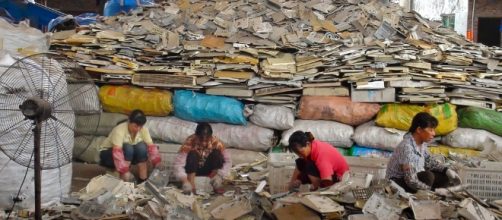china, the only nation dirtier than the United States, according to CO2 emissions, has thrown down the gauntlet on an environmental trade war of sorts. Plastic is the latest shot fired across the West’s bough in an economic trade war. Scrap metal is expected to be next. Some industry experts say the Chinese aren’t looking for a fight with the United States, in spite of their rhetoric. The actual target is EU trash bundled around cardboard and exported to China as recycled commodities.
China’s Green Waste Initiative has been in effect since 2013.
It blocks what China calls “dirtier plastics,” known in the recycling industry as types No. 3 – 7 from import. These include bags, some bottles, mixed fibers and some types of packaging. In addition, several commercial products fall into these categories. Now the largest recycling importer in the world in upping the ante with Operation National Sword 2017 which forbids the import of four classes, 24 kinds of solid wastes.
U.S.-based solid waste company officials told investment analysts they were concerned about the proposed ban but expected to survive. They have seen it before and their recyclables are sorted and clean.
The 800-pound gorilla
However, paper and plastic recycling is big business and the Silk Road runs through China.
More than $5.6 billion in scrap commodities were exported from the United States to China in 2016, according to ISRI, a recycling trade association. U.S. firms exported 13.2 million tons of scrap paper and 1.4 million tons of scrap plastic to China last year.
When Europe and Japan are added to the mix, the giant importer collected more than 7.3 million tons of plastic scrap. China imported 27 million tons of paper more than a quarter of which was mixed paper.
China controls the market price, according to U.S. executives. “They have driven the market from, I'm going to round, 90 to 100, up to now 190,” Waste Connections CEO Ronald J. Mittelstaedt said. “The history is it will move back down at some point probably in the latter part of the fourth quarter, not necessarily to 100, but it could move down to 150.
“And it goes through these cycles,” he added. “We have always said to all investors, that's why we would prefer that a low percentage of our business be based on commodities, because it is a commodity, and it is going to ebb and flow.”
Recycling’s bottom line
The nation’s largest solid waste companies grow by building and buying collection routes, transfer stations and landfills. The transfer stations are important in areas lacking landfills. Their municipal solid waste is stored before being mailed, shipped or trained to landfills. The owner of the transfer station sets the price. The same is true of landfills. If one company owns all three, they’re in the money.
In recent years the giant companies added on energy services and recycling commodity prices moved into the equation.
Methane is a dirty greenhouse gas created as waste in landfills decompose. Landfill owners are responsible for the gas. Owners can either flare it or clean the gas and sell it as a renewable fuel for electricity or natural gas. Only four waste companies are traded publicly.
If a recycling ban is felt in the United States, it will probably be felt in municipalities that use single-stream processing in which households are issued a recycling box or barrel and all recyclables are tossed into it for collection. This can lead to contamination. If municipalities are looking to offset solid waste expenses through recycling commodities, those local governments could face problems.


